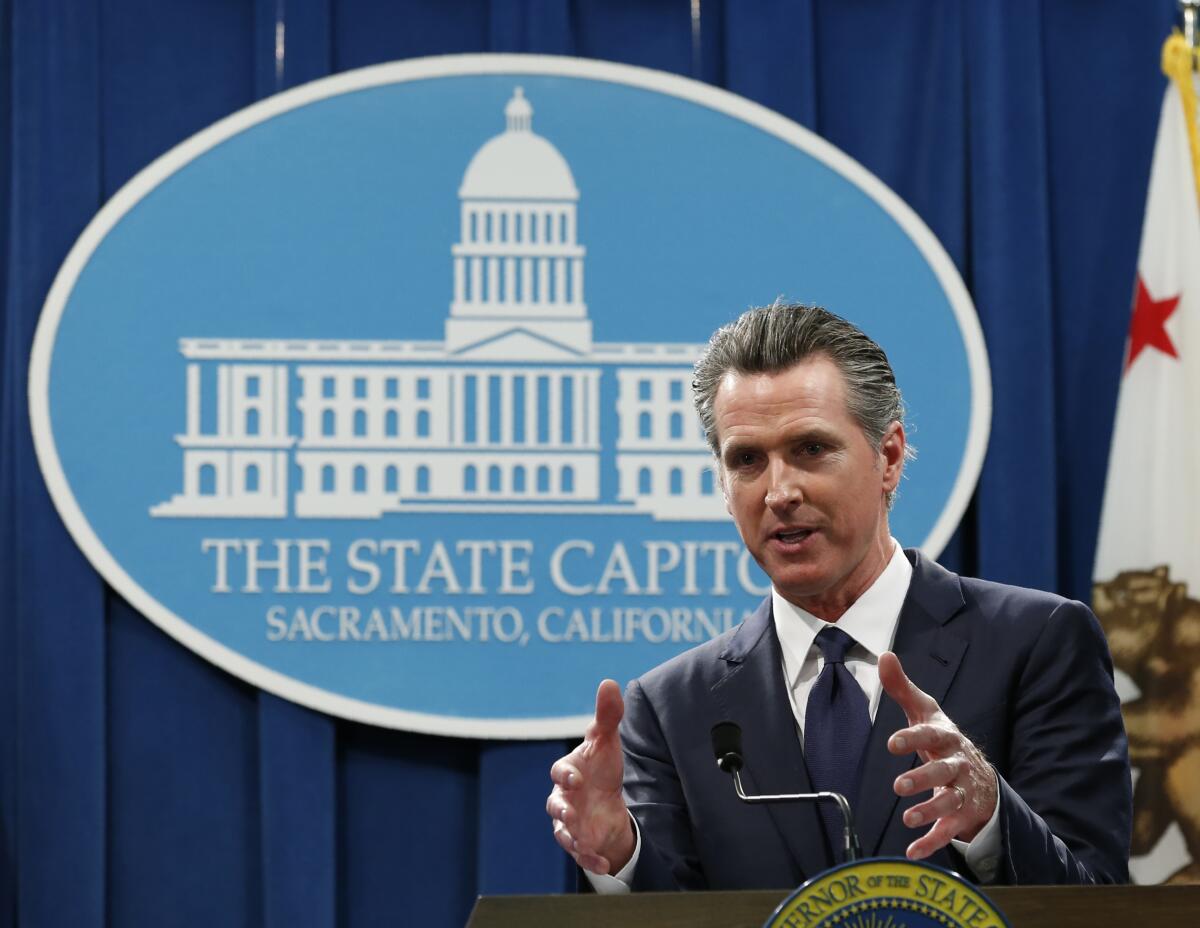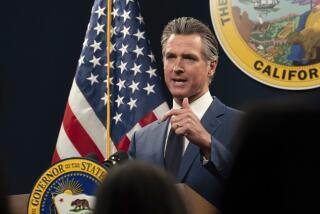Newsom’s budget includes $900 million to address California teacher shortage

Gov. Gavin Newsom’s proposed state budget includes $900 million to recruit and retain teachers, part of a plan to attack a critical statewide shortage of instructors, especially in math, sciences and for students with disabilities.
The plan, included in his $222.2-billion budget unveiled Friday in Sacramento, was among a range of education measures that also includes the creation of an early childhood development department, significantly more money to cover the costs of teaching students with disabilities and a funding boost to the school lunch program, a hedge against possible reductions at the federal level.
Overall, permanent funding increases were modest as Newsom relied on one-time spending as a safeguard against potential leaner revenue in future years. Higher education and K-12 schools combine to represent about half the state’s general fund spending.
The final budget must be approved by the Legislature and will be updated in May.
The governor expressed disappointment with student achievement levels, noting that Latino and black students continue to score on the low end of an unacceptable achievement gap. Despite some measurable performance gains, Newsom said, “none of us are naive, and none of us are spiking the ball.”
Newsom’s proposals would make it more affordable to become a teacher and offer more pay for them to serve where most needed. One proposal would provide $100 million to fund a $20,000 bonus for teachers who work four years in a high-need subject at a high-need school.
The governor said 75% of state school districts face a shortage of fully trained teachers, especially in high school math and science and at all grade levels for students with disabilities. High-need schools have three times as many under-prepared teachers, he said.
In a 2017 survey, two thirds of principals serving schools with high proportions of students of color and students from low-income families reported that they had to leave teaching positions vacant or hire teachers on substandard credentials, according to research from the Palo Alto-based Learning Policy Institute.
Statewide, the number of teachers working on an “emergency-style” permit increased more than five-fold from 2013 to 2017, according to research from the institute. Between 2002 and 2013, enrollment in teacher-education programs declined about 70%, and it’s barely budged upward since.
Newsom’s proposed budget includes more than $400 million toward teacher training programs, including those aimed at bringing in more minority teachers.
“A teacher that looks like you,” Newsom said. “That’s incredibly important.”
“We have got to focus on recruitment,” he said, “and the special subject matters where we are seeing deep systemic underrepresentation.”
Newsom said his advisors looked at comparatively high achievement levels in Massachusetts and improving performance in states such as New Jersey — and the necessity to bolster the teaching force became obvious.
“It’s not all that damn complicated,” he said. “It seems self evident that we should focus and concentrate our efforts in those areas.”
He did not bring up strategies that make it easier to fire bad teachers or rate teachers to improve academic results, which have been key elements of education policy in many states and at the federal level.
“The governor, through his budget, is definitely saying that you can’t get accountability just by measuring and punishing,” said state Board of Education President Linda Darling-Hammond, a Newsom appointee. “You have to get accountability and productivity by investing in people’s capacity to do the job.”
UC Berkeley sociologist and education professor Bruce Fuller commended the creation of a new office for early childhood, calling it a “clear nod toward good, more-efficient government. These funding streams are now scattered among many agencies, like tributaries splitting off during a downpour.”
The group Education Trust-West lauded the addition of 10,000 additional slots in the state’s funding for preschool.
In his remarks, Newsom noted the connection between poverty and student performance and listed measures to address it. These include $300 million in grants for school districts to provide “wrap-around” services, such as healthcare. More broadly, Newsom made connections between the cumulative needs of students and families and government services targeting healthcare, criminal justice and homelessness.
Advocates, including Children’s Defense Fund-California, praised the approach, but not necessarily the execution or total financial commitment.
“We are pleased with the governor’s continued investment in community schools, Medi-Cal and transforming the juvenile justice system,” the organization said in a statement. “With that said, poverty is a significant underlying cause of the poor outcomes and challenges facing California’s children, particularly children of color, and this budget proposal does not fully the address the economic inequities across the state.”
While expressing appreciation for the gains, L.A. schools Supt. Austin Beutner called the state’s school system “woefully underfunded.”
“This budget proposal does not go far enough in funding supports for our most vulnerable students, including students whose families are experiencing homelessness and students with special needs,” Beutner said in a statement.
Newsom said he had to balance legitimate needs with budget limitations. He pegged the overall increase in funding for kindergarten through community college at about 3%.
Newsom also said he would set aside new funding to help school systems pay down pension debts, which have the potential to cripple funding for student programs over the next decade or so.
The University of California and Cal State systems would see a 5% rise — and a cumulative increase of 12% over two years. His higher education proposal also included expanded education opportunities in prisons, more grants for low-income students and resources for immigrant students.
Los Angeles Unified is not as hard-hit as many other districts — especially in rural areas and the Bay Area — for teachers. But it is stretched to fill all classrooms with a fully credentialed instructor. In November, about 85% of its special-education classrooms had a fully qualified teacher, although another 10% were in training to earn their credential.
The district already is benefiting from previous state grants that offset the cost of earning a teaching credential and provide mentoring from a veteran teacher. Such support can be important in retaining teachers. The district also has a program to help teacher aides become fully credentialed instructors, which the new state money also would support.
“We have many communities that are building these programs that recruit people in, and then put them under the wing of a great teacher for a year while they’re getting their credential from a university,” Darling-Hammond said. “Their retention rates are very high. Their effectiveness is high. They become part of the long-term solution, rather than part of the revolving door of people in and out.”
More to Read
Sign up for Essential California
The most important California stories and recommendations in your inbox every morning.
You may occasionally receive promotional content from the Los Angeles Times.











